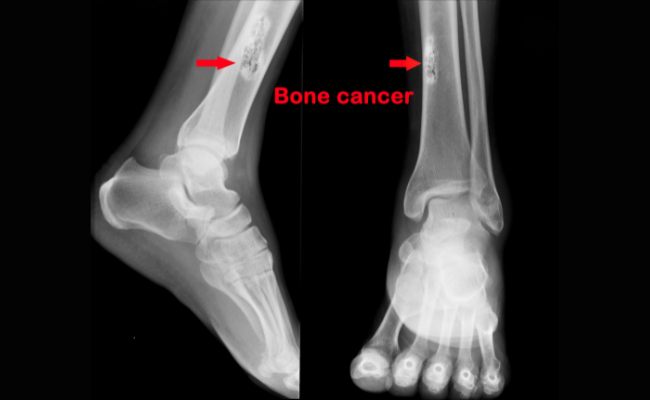What to do incase of Bone Cancer?
- November 02, 2023
- No Comments

What is Bone Cancer?
one cancer, a rare and often aggressive form, arises in bone tissues due to abnormal cell growth, disrupting normal bone function and structure. It encompasses different types like osteosarcoma, Ewing sarcoma, and chondrosarcoma, each characterized by distinct features and affecting specific age groups. This encompasses various cancers originating in the bones, where cancer cell growth adversely affects normal bone tissue. The specific type is determined by the originating cell and tissue. Primary bone cancers develop within the bone, while secondary or metastatic bone cancers involve tumors originating in other organs or body parts and spreading to the bones.
Why is timely recognition of bone cancer symptoms vital ?
Recognizing the signs and symptoms of bone cancer is crucial for early detection and prompt intervention. Bone cancer can cause persistent pain in the affected bone, swelling, and, in some cases, a noticeable lump. Other symptoms may include unexplained weight loss, fatigue, and fractures that occur without significant trauma. Understanding why bone cancer occurs involves recognizing that it can arise spontaneously, without a clear cause, or it may develop secondary to other conditions like Paget's disease or radiation exposure.
How to find bone cancer :
If you suspect bone cancer or experience persistent symptoms, it is imperative to seek medical attention promptly. The diagnostic process for bone cancer typically involves:
- Medical History and Physical Examination: Healthcare professionals will conduct a thorough review of your medical history and perform a physical examination to assess symptoms and identify any abnormal findings.
- Imaging Tests: X-rays, CT scans, MRIs, and bone scans are commonly used to visualize the affected bone, detect tumors, and assess the extent of the cancer's spread.
- Biopsy: A biopsy involves the removal of a small tissue sample from the suspicious area, which is then examined under a microscope to determine if cancerous cells are present. This is a definitive method for diagnosing bone cancer.
- Blood Tests: Blood tests may be conducted to evaluate the overall health of the patient and identify any abnormalities that could indicate the presence of bone cancer.
- Staging: If bone cancer is confirmed, staging is performed to determine the extent of the disease and guide treatment decisions. Staging helps classify the cancer as localized, regional, or metastatic.
Treatment Solutions:
The approach to treating bone cancer depends on various factors, including the type of cancer, its stage, and the overall health of the individual. Common treatment modalities include:
- Surgery: Surgical intervention is often the primary treatment for bone cancer. The goal is to remove the cancerous tumor while preserving as much of the healthy bone and surrounding tissues as possible. In some cases, amputation may be necessary, especially if the cancer has extensively damaged the limb.
- Chemotherapy: Chemotherapy involves the use of drugs to kill cancer cells or stop their growth. It is often employed before surgery to shrink tumors or after surgery to eliminate any remaining cancer cells. Chemotherapy may also be part of the treatment plan for metastatic bone cancer.
- Radiation Therapy: Radiation therapy utilizes high-dose X-rays or other forms of radiation to target and destroy cancer cells. It is often used in conjunction with surgery to ensure that any remaining cancer cells are eradicated. Radiation therapy may also be an option for individuals who cannot undergo surgery.
- Targeted Therapy: Targeted therapy involves drugs that specifically target the molecules involved in cancer growth. This approach aims to block the signals that enable cancer cells to grow and divide.
Benefit Points:
- Early Detection Improves Prognosis: Recognizing the signs of bone cancer and seeking medical attention early can significantly improve the prognosis. Early-stage bone cancer is more treatable, and interventions can be less invasive.
- Multidisciplinary Approach Enhances Treatment: The collaboration of various medical specialists, including orthopedic surgeons, oncologists, and radiologists, ensures a comprehensive and effective treatment plan. This multidisciplinary approach considers the unique aspects of each case.
- Preserving Function and Quality of Life: Advances in surgical techniques and treatment modalities aim to preserve as much of the affected limb or bone as possible, minimizing the impact on functionality and maintaining a higher quality of life for individuals with bone cancer.
- Individualized Treatment Plans: Tailoring treatment plans based on the specific type and stage of bone cancer allows for more personalized care. This approach considers the unique characteristics of the cancer and the individual's overall health.
- Ongoing Research and Innovation: Ongoing research in the field of oncology continually contributes to the development of new treatment options and therapeutic approaches for bone cancer. Participation in clinical trials may offer access to cutting-edge treatments.
Comments (0)